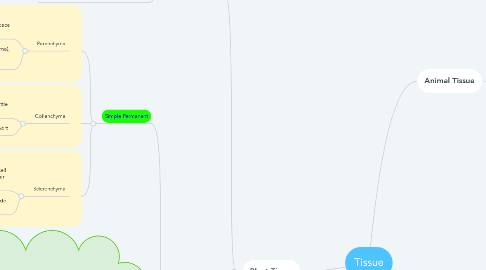
1. Plant Tissue
1.1. Maristemaic tissue
1.1.1. Apical (tips, roots) increase length of stem or roots.
1.1.2. Intercalary (base of leaves and Internodes.
1.1.3. lateral Maristem :- Increases width of stem.
1.2. Permanent tissue
1.2.1. Simple Permanent
1.2.1.1. Parenchyma
1.2.1.1.1. Thin cell wall , live cell, intercellular space is high
1.2.1.1.2. Stores food, Photosynthesis (chlorenchyma), control buoyancy (aeranchyma), stores nutrients and water
1.2.1.2. Collenchyma
1.2.1.2.1. living cells elongated, thick at corners, little intercelluler space
1.2.1.2.2. Flexibility, mechanical support
1.2.1.3. Sclerenchyma
1.2.1.3.1. dead cells, long and narrow cell wall, cell wall is thick due to lignin, no intercellular space
1.2.1.3.2. Makes plant hard and stiff, provide strength
1.2.2. Complex permanent
1.2.2.1. Xylem
1.2.2.1.1. Tracheids :- tubular structure allows transportation of water and minerals vertically
1.2.2.1.2. Vessels :- help tracheids in its function
1.2.2.1.3. Parenchyma :- Stores food, helps in sideways conduction of water
1.2.2.1.4. Fibers :- Supportive in function
1.2.2.2. Phloem
1.2.2.2.1. Sievetubes :- Tubular cells with perforated walls living
1.2.2.2.2. Companion Cells :- help sievetubes in its function, living cell
1.2.2.2.3. Phloem Fibers :- non living
1.2.2.2.4. Phloem Parenchyma :- living
2. Animal Tissue
2.1. Epithelial tissue
2.1.1. Simple Squamous
2.1.1.1. thin and flat cells (lining of mouth, oesophagus)
2.1.1.2. Simple squamous are arranged in a pattern of layers called Stratified Squamous
2.1.2. Columnar Epithelium
2.1.2.1. tall epithelium cells (inner lining of intestine)
2.1.2.2. Some columnar have cilia known as Ciliated Columnar Epithelium (respiratory track)
2.1.3. Cuboidal Epithelium
2.1.3.1. Cube shaped cells, provides mechanical support (lining of kidney tubes)
2.1.3.2. Sometimes a portion of epithelium tissue folds inward, and forms multicellular gland known as Glandular Epithelium
2.2. Connective tissue
2.2.1. Blood
2.2.1.1. Comprises of RBC, WBC and Plasma
2.2.1.2. Plasma contains proteins, salts, hormones
2.2.1.3. Transports digested food, hormones, waste meterial
2.2.2. Bone
2.2.2.1. Forms framework that supports the body. It also anchors the muscles and supports organs.
2.2.2.2. Composed of calcium and phosphorus
2.2.2.3. Strong and non-flexible, hard matrix
2.2.3. Ligament
2.2.3.1. Connects two bones, very elastic, very little matrix
2.2.4. Tendones
2.2.4.1. Connects bones and muscles
2.2.4.2. Fibrous tissue, great Strength, limited flexibility
2.2.5. Cartilage
2.2.5.1. Widely spaced cells, solid matrix of proteins and sugars
2.2.6. Areolar
2.2.6.1. Between skin and muscles, around blood vessels, nerves bone marrow
2.2.6.2. fills space inside organs and helps in repair of tissue
2.2.7. Adipose
2.2.7.1. below skin, between internal organs
2.2.7.2. Filled with fat globules and stores the fat
